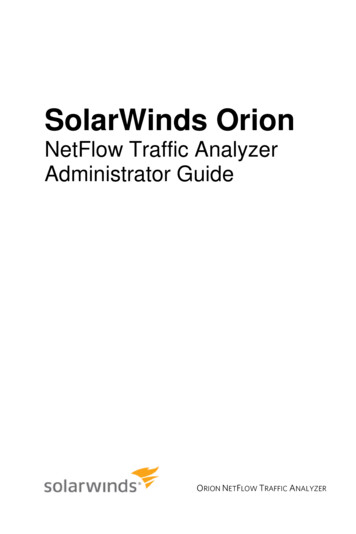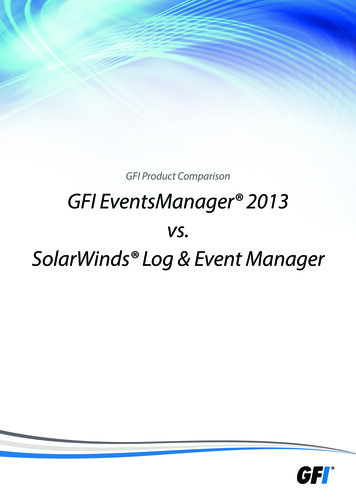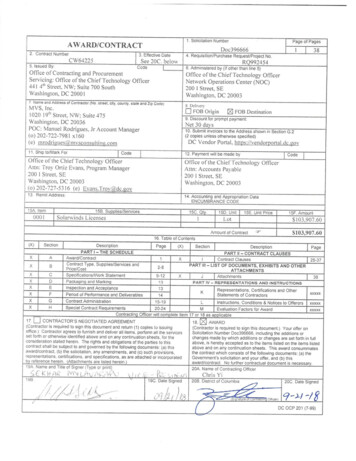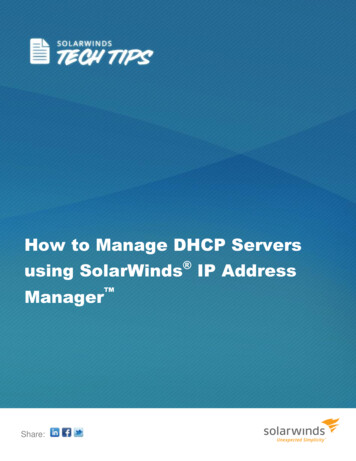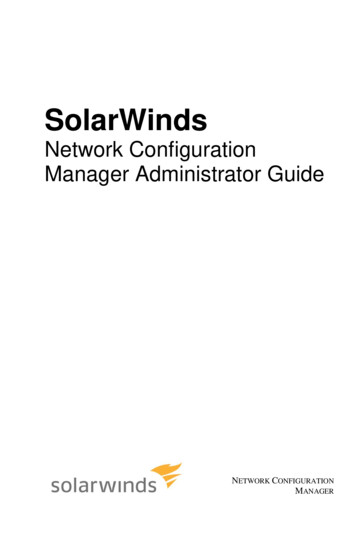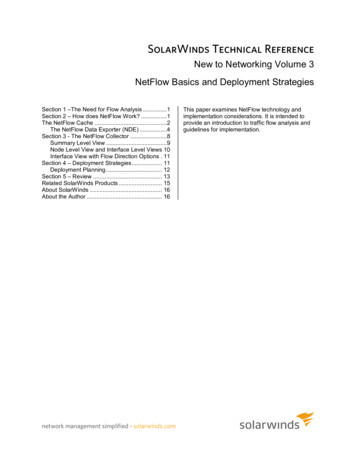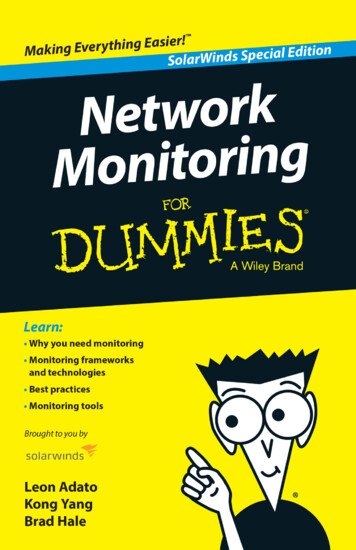
Transcription
These materials are 2016 John Wiley & Sons, Inc. Any dissemination, distribution, or unauthorized use is strictly prohibited.
NetworkMonitoringSolarWinds Special Editionby Leon Adato, Kong Yang,and Brad HaleThese materials are 2016 John Wiley & Sons, Inc. Any dissemination, distribution, or unauthorized use is strictly prohibited.
Network Monitoring For Dummies , SolarWinds Special EditionPublished byJohn Wiley & Sons, Inc.111 River St.Hoboken, NJ 07030‐5774www.wiley.comCopyright 2016 by John Wiley & Sons, Inc.No part of this publication may be reproduced, stored in a retrieval system or transmitted in any formor by any means, electronic, mechanical, photocopying, recording, scanning or otherwise, except aspermitted under Sections 107 or 108 of the 1976 United States Copyright Act, without the prior writtenpermission of the Publisher. Requests to the Publisher for permission should be addressed to thePermissions Department, John Wiley & Sons, Inc., 111 River Street, Hoboken, NJ 07030, (201) 748‐6011,fax (201) 748‐6008, or online at http://www.wiley.com/go/permissions.Trademarks: Wiley, For Dummies, the Dummies Man logo, The Dummies Way, Dummies.com,Making Everything Easier, and related trade dress are trademarks or registered trademarks of JohnWiley & Sons, Inc., and/or its affiliates in the United States and other countries, and may not be usedwithout written permission. SolarWinds and the SolarWinds logo are registered trademarks ofSolarWinds. All other trademarks are the property of their respective owners. John Wiley & Sons,Inc., is not associated with any product or vendor mentioned in this book.LIMIT OF LIABILITY/DISCLAIMER OF WARRANTY: THE PUBLISHER AND THE AUTHOR MAKENO REPRESENTATIONS OR WARRANTIES WITH RESPECT TO THE ACCURACY ORCOMPLETENESS OF THE CONTENTS OF THIS WORK AND SPECIFICALLY DISCLAIM ALLWARRANTIES, INCLUDING WITHOUT LIMITATION WARRANTIES OF FITNESS FOR APARTICULAR PURPOSE. NO WARRANTY MAY BE CREATED OR EXTENDED BY SALES ORPROMOTIONAL MATERIALS. THE ADVICE AND STRATEGIES CONTAINED HEREIN MAY NOT BESUITABLE FOR EVERY SITUATION. THIS WORK IS SOLD WITH THE UNDERSTANDING THAT THEPUBLISHER IS NOT ENGAGED IN RENDERING LEGAL, ACCOUNTING, OR OTHER PROFESSIONALSERVICES. IF PROFESSIONAL ASSISTANCE IS REQUIRED, THE SERVICES OF A COMPETENTPROFESSIONAL PERSON SHOULD BE SOUGHT. NEITHER THE PUBLISHER NOR THE AUTHORSHALL BE LIABLE FOR DAMAGES ARISING HEREFROM. THE FACT THAT AN ORGANIZATIONOR WEBSITE IS REFERRED TO IN THIS WORK AS A CITATION AND/OR A POTENTIAL SOURCEOF FURTHER INFORMATION DOES NOT MEAN THAT THE AUTHOR OR THE PUBLISHERENDORSES THE INFORMATION THE ORGANIZATION OR WEBSITE MAY PROVIDE ORRECOMMENDATIONS IT MAY MAKE. FURTHER, READERS SHOULD BE AWARE THAT INTERNETWEBSITES LISTED IN THIS WORK MAY HAVE CHANGED OR DISAPPEARED BETWEEN WHENTHIS WORK WAS WRITTEN AND WHEN IT IS READ.For general information on our other products and services, or how to create a custom For Dummiesbook for your business or organization, please contact our Business Development Department in theU.S. at 877‐409‐4177, contact info@dummies.biz, or visit www.wiley.com/go/custompub. Forinformation about licensing the For Dummies brand for products or services, contact BrandedRights&Licenses@Wiley.com.ISBN: 978‐1‐119‐27427‐8 (pbk); ISBN: 978‐1‐119‐27428‐5 (ebk)Manufactured in the United States of America10 9 8 7 6 5 4 3 2 1Publisher’s AcknowledgmentsSome of the people who helped bring this book to market include the following:Project Editor: Carrie A. JohnsonEditorial Manager: Rev MengleBusiness Development Representative:Kimberley SchumackerProduction Editor: SelvakumaranRajendiranThese materials are 2016 John Wiley & Sons, Inc. Any dissemination, distribution, or unauthorized use is strictly prohibited.
IntroductionPicture this scenario: You get to your desk at 9:00 a.m.sharp, having had a great morning workout, followed bya shower, a fantastic cup of coffee, and a frustration‐free driveto the office. You’re fresh and focused and ready to make aserious dent in that growing to‐do list, which includes curiousitems like users complaining that “the Internet” gets reallyslow every so often, and the CFO thinks we’re overpaying forWAN bandwidth. How much are we using?Logging on to your PC, you notice that no emails have comein overnight. “That’s odd,” you’re thinking. Seeing you arrive,your buddy now walks over and says, “Looks like something’swrong with email.” You log on to the email server and find outthat it’s . . . well, you don’t actually log on to the email server.The remote desktop won’t make a connection. You try pinging the box, and there’s no response. You wonder to yourselfif the problem is in the network or somewhere else in thesystem. With a sinking feeling, you make the long journey tothe computer room. All hope of working on your to‐do list isnow gone as you stab a finger at the server’s power switch. Afew moments later, you’re logged on at the console. A pop‐upalert on the screen tells you that one of the drives is completely full.Much . . . (much!) later in the day, a picture forms of whathappened. Sometime during the night (2:30 a.m. to be exact)the data drive filled up, causing mail services to stop. Shortlyafter that, errors on the system drive reached a critical point,and the entire system crashed. Meanwhile, in the heat of fighting this fire, you didn’t dig deeper to note that the data drivehas been hovering at 95 percent capacity for over a week. Andthe drive that contains the operating system has been throwing read/write errors every 15 minutes for the last 17 days.About this time, your manager, who’s been keeping a respectful distance while you worked, lets you know that the CEO isback from his contract discussions overseas. During the flighthome, the CEO needed to send some follow‐up documentationThese materials are 2016 John Wiley & Sons, Inc. Any dissemination, distribution, or unauthorized use is strictly prohibited.
2Network Monitoring For Dummies, SolarWinds Special Edition to the customer. When the corporate email wasn’t responding, he resorted to creating a professional‐sounding Gmailaccount and sent the files from there. The three of you arescheduled to sit down and debrief the situation in 30 minutes.You start to pull some notes together for what you predictwill be an uncomfortable conversation. Well, it was going tobe a great day.About This BookThe situation you read above may be a typical one for you inyour Information Technology (IT) monitoring scope. If youcan relate, then this book is for you! Network Monitoring ForDummies, SolarWinds Special Edition, provides an introduction to IT monitoring for someone who is familiar with ITin general but not with monitoring as a discipline. As such,(almost) no former knowledge or experience is requiredbefore delving into the chapters of this book. If you alreadyhave experience with monitoring, this may not be the bookfor you. But then again, couldn’t we all use a refresher? Itcouldn’t hurt.We have attempted to make this book tool‐agnostic. Thepurpose of this book is to give you a basic understanding ofwhy you need monitoring, what the monitoring tools are, andsome best practices of networking monitoring.Icons Used in This BookThis book uses the following icons to call your attention toinformation you may find helpful in particular ways.The information marked by this icon gives you certain detailsthat are important to remember. This way, you can easily spotnoteworthy information when you refer to the book later.This icon points out extra‐helpful information, including waysto save time, money, and headaches.Paragraphs marked with the Warning icon call attention tocommon pitfalls that you may encounter.These materials are 2016 John Wiley & Sons, Inc. Any dissemination, distribution, or unauthorized use is strictly prohibited.
Chapter 1Monitoring as a DisciplineIn This Chapter Discovering that monitoring isn’t side work Seeing the benefits of network monitoring Understanding how an effective monitoring solution is built“Monitoring as a discipline” means devoting your focusas an IT professional to ensuring your network,servers, applications, and so on are all stable, healthy, andrunning at peak efficiency. It means not just being able to tellthat a system has crashed, but more importantly to tell whena system will crash, and intervening so the crash is avoided.This chapter gives you insight into monitoring as a discipline,the benefits of monitoring, and the difference between monitoring and managing.It’s Not Work You Do“On the Side”About a decade ago, there were no InfoSec professionals, no“white hat hackers,” no pen testers. Network security, such asit was, was typically handled by a network or server admin whowas drawn to security issues, who had an interest, and who feltpassionately about keeping his or her environment safe. Tenyears later, no company would think of excluding informationsecurity from the list of must‐have in‐house expertise.We believe that the same is happening for monitoringprofessionals. Currently, many IT shops run without anyThese materials are 2016 John Wiley & Sons, Inc. Any dissemination, distribution, or unauthorized use is strictly prohibited.
4Network Monitoring For Dummies, SolarWinds Special Edition significant monitoring solution. Others go about it in a piece‐meal fashion, allowing teams or even individuals to deploysolutions with no thought to interoperability, scalability, orstandards.But in the not‐so‐distant future, we imagine a world where theidea of having a monitoring team is as natural as the teams ofnetwork, server, virtualization, storage — and yes, security —administrators we have today.To get to that future, people who are drawn to monitoring, whohave an interest and a passion for it, need the information toget up to speed on common terms, concepts, and techniques,and then they need the tools to turn that knowledge intoresults. This book is dedicated to imparting knowledge andexperience gleaned from years of focus on building up ourmonitoring expertise, and from thousands of engagementswith customers who had the same goal as you do.Looking at the Benefitsof Network MonitoringIf you’ve worked in IT for more than 15 minutes, you know thatsystems crash unexpectedly, users make bizarre claims abouthow the Internet is slow, and managers request statistics,which leaves you scratching your head wondering how tocollect them in a way that’s meaningful and doesn’t consignyou to the headache of hitting Refresh and spending half theday writing down numbers on a piece of scratch paper just toget a baseline for a report.The answer to all these challenges (and many, many more)lies in effectively monitoring your environment, collectingstatistics, and/or checking for error conditions so you can actor report effectively when needed. This goes well beyond apassive “make sure everything is green” approach to one thatincludes resource optimization, performance optimization,and proactive prevention and remediation.Industry studies peg the cost of downtime in the hundreds ofthousands of dollars per hour so the benefits of monitoringare indisputable:These materials are 2016 John Wiley & Sons, Inc. Any dissemination, distribution, or unauthorized use is strictly prohibited.
Chapter 1: Monitoring as a Discipline5 Improved operational efficiency and reduced costs Improved time‐to‐resolution and reduced downtime More efficient use of resourcesBuilding an EffectiveMonitoring SolutionAttaining the benefits of monitoring (see the preceding section) is easier said than done. Saying “let’s monitor our ITenvironment” presumes that you know what you should belooking for, how to find it, and how to get it without impactingthe system you’re monitoring. You’re also expected to knowwhere to store the values, what thresholds indicate a problemsituation, and how to let people know about a problem in atimely fashion.Yes, having the right tool for the job is more than half thebattle. But, it’s not the whole battle, and it’s not even wherethe skirmish started.To build an effective monitoring solution, the true startingpoint is learning the underlying concepts. You have to knowwhat monitoring is before you can set up what monitoringdoes.Network monitoring is the phrase used to describe the practiceof continuously monitoring the network and providing notifications to an administrator (probably you if you’re readingthis book) when an element of the network fails. Monitoring isusually performed by software or hardware tools and doesn’thave an effect on the operation or condition of the network.Monitoring can be performed passively or actively:monitor[mon‐i‐ter]verbto observe, record, or detect (an operation or condition)with instruments that have no effect upon the operationor conditionThese materials are 2016 John Wiley & Sons, Inc. Any dissemination, distribution, or unauthorized use is strictly prohibited.
6Network Monitoring For Dummies, SolarWinds Special Edition This is in contrast to management in which the administratorgoverns or controls the environment:manage[man‐ij]verbto handle, direct govern or control in action or useThese materials are 2016 John Wiley & Sons, Inc. Any dissemination, distribution, or unauthorized use is strictly prohibited.
Chapter 2Monitoring 101In This Chapter Looking into monitoring basics Knowing monitoring technologies Diving deeper into monitoring your networkEvery monitoring system, regardless of the vendor orpackaging, utilizes basic monitoring principles and technologies. This chapter lays out those core techniques andthen gives you a deeper look into monitoring your network.Defining the Monitoring BasicsA few fundamental aspects of a monitoring system existacross the board, no matter what software you use, or theprotocol, or the technique. These basic technologies used formonitoring include the following: Element: An element is a single aspect of the deviceyou’re monitoring, which returns one or more pieces ofinformation. Acquisition: How you get information is another key concept. This process is called acquisition. Does your monitoring routine wait for the device to send you a statusupdate (push), or does it proactively go out and poll thedevice (pull)? Frequency: Closely tied to acquisition (see the precedingsection) is how often information comes back — aptlynamed frequency. Does the device send a “heartbeat”every few minutes? Does it send only data when there’s aproblem?These materials are 2016 John Wiley & Sons, Inc. Any dissemination, distribution, or unauthorized use is strictly prohibited.
8Network Monitoring For Dummies, SolarWinds Special Edition Data retention: Monitoring, by its very nature, is data‐intensive. Whether the acquisition method is push orpull, those statistics typically have to go somewhereand they pile up pretty quickly. At its simplest level, dataretention is a Yes or No option. Either the statistic is 1)collected, evaluated, acted on, and then forgotten, or 2)data is kept in a data store. Threshold: One of the core principals of monitoring isthat you collect a statistic and see if it has crossed a lineof some kind. It can be a simple line (is the server on oroff?), or it can be more complex. Regardless, that line,which is crossed, is called a threshold. Reset: Reset is the logical opposite of threshold. It marksthe point where a device is considered “back to normal.” Response: What happens when a threshold is breached?Response defines that aspect. A response could be tosend an email, play a sound file, or run a predefinedscript. Requester: With all the talk about monitoring, little hasbeen said (yet) about where the monitoring is occurring —meaning, from what point in the environment are themonitoring statistics being requested. In its simplestterms, you have two choices: either a piece of softwarerunning on the monitored device itself (for example, anagent), or some location outside of the monitored device(agentless).Monitoring TechnologiesRegardless of what monitoring vendors will have you believe,a finite and limited number of technologies can be used tomonitor. Where the sophistication comes in is with the frequency, aggregation, the relevance of displays, the ease ofimplementation, and other aspects of packaging.PingPing sends out a packet to the target device, which (if it’s upand running) sends an “I’m here” type response. The result ofa ping tells you whether the device is responding at all (up)and how fast it responded.These materials are 2016 John Wiley & Sons, Inc. Any dissemination, distribution, or unauthorized use is strictly prohibited.
Chapter 2: Monitoring 1019SNMPSimple Network Management Protocol (SNMP) has a fewpieces that combine to provide a powerful monitoring solution. SNMP is comprised of a list of elements that return dataon a particular device. It could be CPU or the average bits persecond transmitted in the last five minutes. SNMP providesdata based on either a Trap trigger (when one of the internaldata points crosses a threshold) or an SNMP poll request.ICMPThe Internet Control Message Protocol (ICMP) is used bynetwork devices like routers and switches to send error messages indicating that a host isn’t reachable along with somediagnostics.SyslogSyslog messages are similar to SNMP traps. A syslog serviceor agent takes events that occur on the device and sendsthem to a remote listening system (Syslog destination server).Log fileAn application or process writes messages to a plain text fileon the device. The monitoring piece of that comes in the formof something that reads the file and looks for trigger phrasesor words.Event logEvent log monitoring is specific to Windows. By default, mostmessages about system, security, and (standard Windows)applications events are written here. Event log monitorswatch the Windows event log for some combination ofEventID, category, and so on, and perform an action when amatch is found.These materials are 2016 John Wiley & Sons, Inc. Any dissemination, distribution, or unauthorized use is strictly prohibited.
10Network Monitoring For Dummies, SolarWinds Special Edition Performance monitor countersPerformance monitor (or PerfMon) counters are anotherWindows‐specific monitoring option that can reveal a greatdeal of information, both about errors on a system andongoing performance statistics.WMIWindows Management Instrumentation (WMI) is a scripting language built into the Windows operating system thatfocuses on collecting and reporting information about thetarget system.ScriptRunning a script to collect information can be as simple orcomplicated as the author chooses to make it. In addition, thescript might be run locally by an agent on the same deviceand report the result to an external system. Or, it might runremotely with elevated privileges.IP SLAInternet Protocol Service Level Agreements (IP SLAs) area pretty comprehensive set of capabilities built into Ciscoequipment (and others nowadays, as they jump on the bandwagon). These capabilities are all focused on ensuring theWAN, and more specifically VoIP, environment is healthy byusing the devices that are part of the network infrastructureinstead of requiring you to set up separate devices to runtests.FlowStandard monitoring can tell you that the WAN interface onyour router is passing 1.4 Mbps of traffic. But who is usingthat traffic? What kind of data is being passed? Is it all HTTP,FTP, or something else? Flow (most commonly referred toas NetFlow) monitoring answers those questions. It sets upthe information in terms of conversations and monitors who,what, and how network traffic is being used.These materials are 2016 John Wiley & Sons, Inc. Any dissemination, distribution, or unauthorized use is strictly prohibited.
Chapter 3Going beyondMonitoring BasicsIn This Chapter Looking into device availability, fault, and performance Working with traffic and bandwidth Understanding WAN and IP address monitoringMonitoring your network allows you to be alerted topossible pot holes before your users hit them at topspeed. In this chapter, we provide insight into monitoringyour network.Device Availability, Fault,and PerformanceIn most modern network monitoring systems, devices aremonitored for the following: Availability (is the device reachable?) Faults (detection, isolation, correction, and logging ofnetwork events) Performance (efficiency of the network, includingthroughput, utilization, error rates, and response time)Monitoring here relies primarily on SNMP and ICMP withmore advanced monitoring taking advantage of packetinspection. Some of the key metrics that you should look atinclude response time and packet loss, CPU load and memory utilization, and hardware health details.These materials are 2016 John Wiley & Sons, Inc. Any dissemination, distribution, or unauthorized use is strictly prohibited.
12Network Monitoring For Dummies, SolarWinds Special Edition Traffic and BandwidthUnderstanding how network bandwidth is being used is critical in ensuring the availability and performance of businessservices. Bandwidth and traffic usage are most often monitored using the Flow (most commonly referred to as NetFlow)technology that is built into most routers by looking at“ conversations” between devices.When monitoring traffic and bandwidth, pay attention to Interface utilization Applications, users, and protocols generating traffic(who and what are generating traffic) Endpoints (where traffic is coming from and going to) Conversations (who is talking to whom)WANYou may not own the WAN between your sites and remotelocations and can’t directly monitor the fault, availability, andperformance of the devices within the WAN. If that’s the case,you can use a technology such as IP SLA to generate synthetictraffic or operations to measure the performance between twolocations or devices, determining the performance of the WAN.IP SLA is especially beneficial when monitoring applicationsthat are particularly sensitive to delay, jitter, or packet losssuch as VoIP or video streaming.IP Address MonitoringA network can have thousands of IP addresses in use at anygiven time. A duplicate IP assignment, exhausted subnetor DHCP scope, or misconfigured DHCP or DNS service willcause a network fault.Look for a solution that monitors these IP resources and thatcan proactively alert you of problems to help you plan fororderly expansion.These materials are 2016 John Wiley & Sons, Inc. Any dissemination, distribution, or unauthorized use is strictly prohibited.
Chapter 3: Going beyond Monitoring Basics13Discovering the DifferentMonitoring ToolsAfter all is said and done, you still need to buy or build a toolor set of tools that help you monitor all the elements of the ITstack. This can be done with discrete specialized tools thatmonitor a specific element (for example, network m onitoring,storage monitoring, virtualization monitoring, and so on)or with a fully integrated suite of products that provides acommon platform across the entire stack. Each approach hasits advantages and disadvantages.Regardless of which approach you choose, all software vendors are selling solutions that work from the same basicplaybook. What should you look for as a differentiating factor?What is it, exactly, that makes brand X so much better thanbrand Y? The answer has as much to do with you and yourorganization as it does with how monitoring gets done.Will your monitoring team be one person who is also yourserver team and network team and helpdesk team and database team? If so, you probably need a tool that sacrificescomprehensive options for simplicity and manageability. Doesyour organization need absolute flexibility so that the monitoring solution is the one‐stop‐shop for all your needs? Youwill pay more, and require more staff, but at the end of theday (or month, or more likely year) you will have a softwaresuite that fits you like a glove.With all of that said, the nontechnical items you should consider include the following: Cost to purchase and install: This includes hardwarerequirements and the specific needs for your environment. Do you need a separate system to monitor devicesin your firewall and/or remote sites? How many monitoring systems do you need for all the devices in your company? And so on. Ongoing maintenance cost: These include license costsin year two and beyond.These materials are 2016 John Wiley & Sons, Inc. Any dissemination, distribution, or unauthorized use is strictly prohibited.
14Network Monitoring For Dummies, SolarWinds Special Edition Support requirements: How many people are neededto maintain the system? This is one of those questionsthat you should never trust the vendor to answer. Talk tosome other companies that are using the software. How much customization is needed? Again, talking toother companies is extremely useful here.To learn more about SolarWinds network monitoring solutions,visit www.solarwinds.com.These materials are 2016 John Wiley & Sons, Inc. Any dissemination, distribution, or unauthorized use is strictly prohibited.
Chapter 4Getting to Knowthe SolarWindsFramework: DARTIn This Chapter Finding out what’s going on Knowing when something breaks Fixing the problem Pinpointing the root cause of the problemThis chapter offers practical advice that helps you doyour job every day. To that end, we now introduce theSolarWinds framework, DART: Discovery Alerting Remediation TroubleshootingDiscoveryDiscovery is finding out what’s going on. This simple p rincipleshould guide you in understanding the health and risks ofyour network assets. Discovery begins by establishing a point‐in‐time baseline for the health and risks of your network. Onceyou understand what’s in your network and each component’shealth and risks, you should look at addressing changes thatoccur in the network.These materials are 2016 John Wiley & Sons, Inc. Any dissemination, distribution, or unauthorized use is strictly prohibited.
16Network Monitoring For Dummies, SolarWinds Special Edition Discovery serves three key functions: Identifies all your assets and resources and shows theirconnected context Provides a point‐in‐time baseline for the performanceand risk of your network Populates the data used to calculate how efficient yournetwork implementation isAlertingAlerting is finding a simple way to know when somethingbreaks. The essence of this skill is to ensure that you’re notconstantly in front of a monitor because, frankly, no one hastime for that. The noise should be filtered from the signalsuch that only the most important information is presentedto you. The information that’s highlighted should allow youto take corrective actions on a much narrower problem set.As you gain more experience, you’ll be more adept at creatingmore meaningful alerts to bypass even more noise.To truly appreciate the importance of alerting, you have tounderstand the pain that comes with incorrect alerting. Thedata from the network, systems, VMs, and applications beingmonitored can provide valuable insights into the ecosystem,but that data can easily overwhelm the admin. A constantstream of false alarms and data noise can result in paralysisby over‐analyzing thresholds. Suffice it to say, when it comesto alerting, more isn’t always better.In addition to cutting through the metrics noise and datadeluge, alerting serves two other critical functions: Records that a particular event has occurred, or a threshold has been reached or exceeded Triggers a notification to an admin for that given eventAlerting provides the first clues that an event is about tohappen, is happening, or has happened. It guides the firststeps on the path toward troubleshooting and remediatingan event.These materials are 2016 John Wiley & Sons, Inc. Any dissemination, distribution, or unauthorized use is strictly prohibited.
Chapter 4: Getting to Know the SolarWinds Framework: DART17The alert life cycle spans three primary stages: Alert creation means deciding on key health andperformance indicators and setting thresholds forthose indicators. Alert handling and routing necessitates creating ameaningful notification in response to the alert trigger,and communicating that alert to the right person whocan take the proper action to prevent or resolve theissue. These notifications can include emails, SMS messages, or automated calls to cellphones. Alert feedback involves being able to update alertsbased on changes or trigger conditions to ensure theright balance of notification to false alarms.RemediationRemediation is fixing the problem. The core principle is to getthe network in working order as fast as possible. For an ITadmin, this is a race against time. Every minute an applicationor system is down equates to lost opportunity, and often, lostrevenue.As our Head Geek Thomas LaRock so eloquently stated, “Asan IT administrator, you get paid for performance, but youkeep your job with recovery.” Your job is on the line whenstuff happens. So, when stuff happens, you must take a deepbreath and repeat these three magic words: Stop. Drop. Roll.Yes, these are the same steps you take if you’re on fire. Theywork for IT fires as well: Stop Assess the situation. Focus on the steps that will lead to resolution. Drop Drop all distractions like unnecessary and unconnected services and processes. Remove all unnecessary pseudo‐IT chefs from thekitchen. This means anyone not directly responsible for and connected to the stack that you’retrying to restore.These materials are 2016 John Wiley & Sons, Inc. Any dissemination, distribution, or unauthorized use is strictly prohibited.
18Network Monitoring For Dummies, SolarWinds Special Edition Roll Roll out your recovery plan to get your networksystems back in working order. Monitor key performance indicators to make sureeverything is stable following the
2 Network Monitoring For Dummies, SolarWinds Special Edition . . Network security, such as it was, was typically handled by a network or server admin who was drawn to security issues, who had an interest, and who felt passionately about keeping his or her environment safe. TenFile Size: 1MBPage Count: 29
